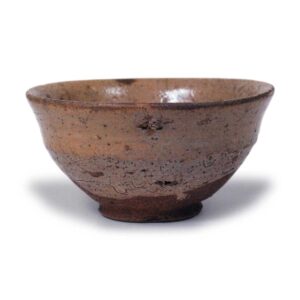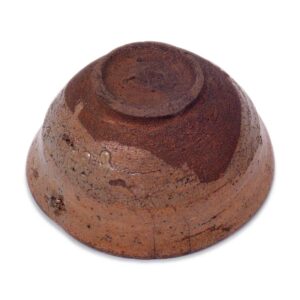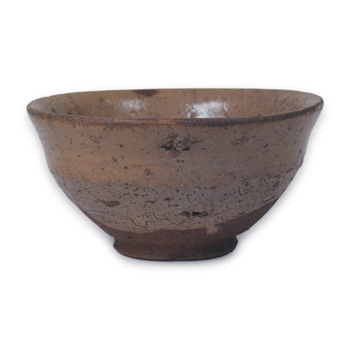

Karatsu Tea Bowl, Three Treasures
One name: Korehankaratsu
Important Cultural Property
Height: 7.6 – 7.9cm
Mouth diameter: 15.3-15.8cm
Outer diameter of stand: 6.6 cm
Height: 0.6-0.9cm
This tea bowl was known as the most famous bowl in Karatsu. It is said that the name “Korekan” comes from a doctor named Korekan Nakao, who owned this bowl, and it is also said that this bowl was made according to his taste, but as there is no data to support this claim, it is difficult to be sure.
The clay is rough and coarse, mixed with small sand, and is tightly baked, giving it a rock-like appearance.
It has a slight iron content, and the guttation is burnished to a light brownish color, but is stained with brownish tannin and darkened to a dark brown. A translucent, moist, shiny, dull glaze is applied inside and out, and below the outer rim is dewy.
The shape of the bowl is slightly warped at the rim, with a wide mouth and a short, wide, low stand, reminding at first glance of a persimmon sash. It is a tea bowl with a thick, sturdy and heavy feeling, which is rare for Karatsu.
It is a tea bowl with a thick construction and a solid, heavy appearance, which is rare for Karatsu. The interior of the vessel has a triangular shaped glaze with a thick bluish glaze around it. There are five small marks, and the blotches around them, which look like leaks from the rain, add to the elegance of the piece. The firing was rather sweet, and some areas turned a loquat color due to a neutral flame, while others turned a bluish color due to reduction. There is one stone haze on the body and several gutters on the mouth, but they are not noticeable.
The shape is in the style of a persimmon belt, but it is a sturdy and heavy tea bowl reminiscent of a well, and should be called an outstanding bowl in Karatsu.
Incidentally, Yusaku Imaizumi wrote in his “History of Japanese Ceramics” that “the three types of Karatsu, Korean Karatsu and Seto Karatsu, though they have the name of Karatsu, are not from our country at all. The coloring of Korehankaratsu is a little reddish, but it is definitely not our Karatsu ware”. Some people think that Korehanto-karatsu was not made as a tea bowl, and that it was originally a miscellaneous ware, but I think that it was made as a tea bowl because of its shape and the way it was glazed.
Korehanto-karatsu was probably made at the end of the Momoyama period and the beginning of the Edo period, but it is not clear at which kiln in Karatsu it was made. It is probably a karatsu of the Matsuura lineage, but we do not know for sure whether it is an Iidora jar or a Fuji no Kawauchi.
Attachments are,
Inner box, black lacquered, cover with inscription in gold powder script, “Korehanka Karatsu Tea Bowl, Sanpo
This bowl was handed down to the Konoike family together with Nakao Karatsu and is known as a famous Karatsu bowl.



